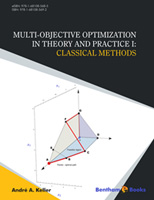Editor: André A. Keller; published on December 13, 2017.
In multi-objective optimization (MOO) problems, the objectives are often conflicting. The goal is to find trade-off solutions that represent the best compromises among the objectives. Classical methods for solving MOO problems consist of the Zeleny’s simplex algorithm, the weighting methods simplex method, and the preference-based techniques including the value function method, goal programming, and the generalized center method.
The first Chapters of this book focus on the design of current MOO problems, the complexity of such problems with nonlinearities and uncertainties, and the theory of Pareto optimality. The next Chapters introduce the founding solving methods and preference-based methods. The last Chapters deal with the special structures of MOO problems, such as mixed-integer programming, hierarchical optimization, fuzzy logic programming, and bimatrix games. This project is typically user-oriented with theoretical and practical aspects. It includes detailed examples, illustrative figures, test functions, and small-size applications from the literature.
The mathematical foundations of programming relate to two significant contributions, namely the Theory of Games and Economic Behavior by John von Neumann and Oskar Morgenstern in 1944, and the simplex method discovered by George B. Dantzig in 1947. Paradoxically, the origin of multi-objective optimization (MOO) goes back to earlier works by Francis Y. Edgeworth in 1881, and Vilfredo Pareto in 1906. The two leading economists developed the theory of indifference curves and defined the basic concept of optimality for problems where multiple objectives are to be optimized. In such problems, the objectives are often conflicting. The goal is to find trade-off solutions that represent the best compromises among the objectives.
Classical methods for solving MOO problems consist of the Zeleny’s simplex algorithm, the weighting methods simplex method, and the preference-based techniques including the value function method, goal programming, and the generalized center method. The development of a multi-objective approach accelerated in the mid-1980s with the help of evolutionary algorithms for solving real-world multi-objective problems. This project consists of two eBooks titled ‘Multi-objective optimization in theory and practice.’
The first eBook treats ‘classical methods’ and the second is on ‘Metaheuristic algorithms.’ This project is an attempt to handle the most significant aspects of the real-life complexities in decision-making. Various difficulties arise from non-convexities, nonlinearities, and non-differentiability of objective functions and side-constraints, multiple conflicting goals, a multiplicity of global and local solutions, uncertainties due to inaccurate data, etc. This project reviews and evaluates multi-objective programming models using several software packages.
This eBook is on classical methods for solving MOO problems. This eBook deals with the problems of operations research involving multiple objectives for the same decision-maker or several decision-makers. These decision makers can be organized hierarchically or compete in a standard game. The environment in which these operations take place can be deterministic, stochastic, or fuzzy. In a deterministic environment, the data and behaviors are known. In a stochastic environment, uncertainty prevails. In a fuzzy environment, data and behavior are imprecise.
This book proposes the classical techniques to bring solutions to these problems. These techniques can suffice to solve standard case studies for which there are few difficulties regarding formalization and the size of the applications. But we will see in the second eBook (which will be published later) that compex situations will require the use of other methods of successive approximation research.
This book consists of nine Chapters. The first three Chapters focus on the design of current MOO problems (Chapter 1), the complexity of MOO problems with nonlinearities and uncertainties (Chapter 2), and the theory of Pareto optimality (Chapter 3). The next two Chapters introduce the founding solving methods (Chapter 4) and the preference-based methods (Chapter 5). The last four Chapters deal with the special structures of MOO problems, such as the mixed-integer programming (Chapter 6), hierarchical optimization (Chapter 7), fuzzy logic programming (Chapter 8), and bimatrix games (Chapter 9). This project is typically user-oriented with theoretical and practical aspects.
This project includes detailed examples, illustrative figures, test functions, and small-size applications from the literature. The calculations are performed using, in particular, the commercial Mathematica® software, and implementing other free software packages. The choice was to retain a leading commercial software and other free software packages easy to implement. Mathematica® is a language which the author believes is capable of utlilizing current mathematical expressions. Another interest of Mathematica® is to have several extra packages in areas such as discrete mathematics (i.e., combinatorics and graph theory), fuzzy logic, and game theory.
About the Author:
André A. Keller (Prof.) is at present an Associated Researcher at the Center for Research in Computer Science, Signal, and Automatic Control of Lille, by the University de Lille in France. He received a Doctorat d’Etat’ (PhD.) in Economics/ Operations Research from the University of Paris 1 Panthéon-Sorbonne, and a post-doctorate from the University Paris X Nanterre. He is a Reviewer for the international journals major publishers such as Elsevier, Hindawi, Springer, World Academic Publishing, World Scientific, WSEAS Press. He taught applied mathematics (optimization techniques) and econometric modeling, microeconomics, the theory of games and dynamic macroeconomic analysis. His experience centers are in building and analyzing large-scale macroeconomic systems, as well as forecasting. His research interests include high-frequency time-series modeling with application to the foreign exchange market, discrete mathematics (graph theory, combinatorial optimization), stochastic differential games and tournaments, circuit analysis, optimal control under uncertainties. (fuzzy control).

